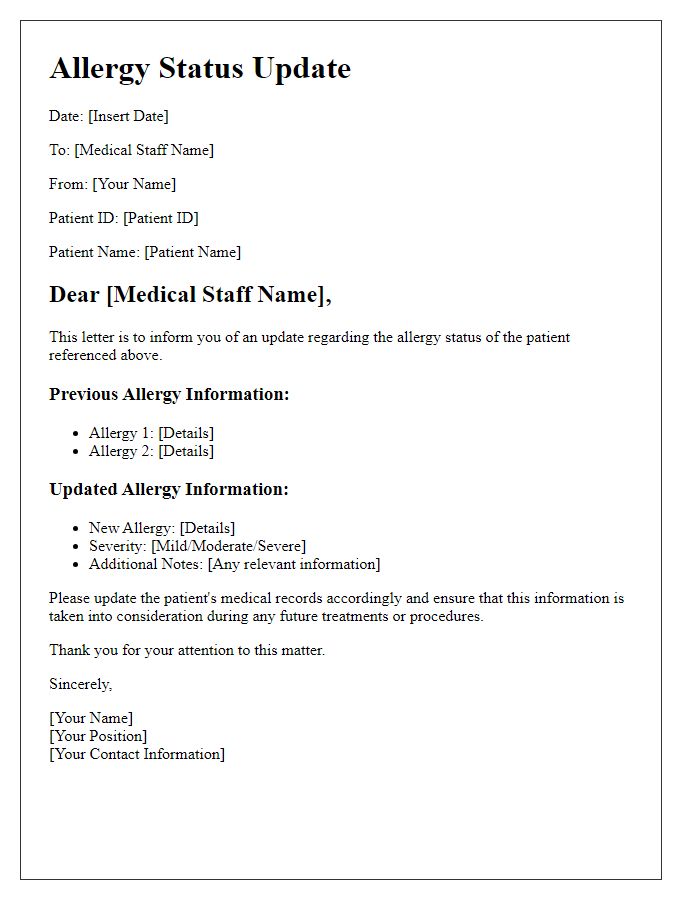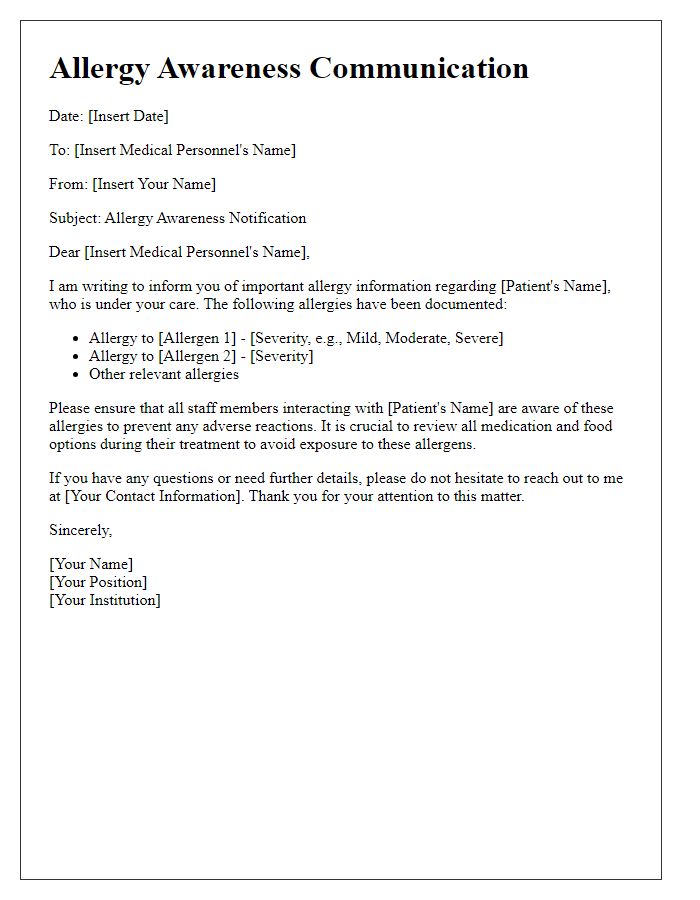Are you looking to ensure clear communication about your allergies with your healthcare provider? Providing detailed allergy information can greatly enhance your safety and overall care experience. This letter template not only streamlines the process but also emphasizes the importance of transparency in your healthcare journey. Let's dive into how you can effectively convey your allergy information to your provider!

Patient Information
When dealing with allergies, it is crucial to provide comprehensive information to healthcare providers to ensure patient safety and optimal care. Patients should detail specific allergens that trigger adverse reactions, such as peanuts (a common nut allergen), gluten (found in wheat, barley, and rye), or latex (material commonly used in medical gloves). It is important to note the severity of past allergic reactions, which may range from mild symptoms like hives to severe anaphylaxis (a life-threatening reaction requiring immediate intervention). Additionally, including medications taken regularly, like antihistamines for allergy management, helps in crafting effective treatment plans. Having a clear record of past allergy tests, such as skin prick tests or blood tests, can also aid healthcare providers in understanding the patient's allergy profile. Accurate and detailed information improves communication and fosters patient-centered care in clinical settings.
Comprehensive Allergy List
A comprehensive allergy list is essential for healthcare providers to ensure patient safety and effective treatment. Common allergens include pollen from trees, grasses, and weeds, as well as food substances such as peanuts, tree nuts, shellfish, dairy, and eggs. Medication allergies often include penicillin, sulfa drugs, and aspirin, which can lead to severe reactions. Environmental triggers may encompass dust mites, mold, latex, and specific animal dander, particularly from cats and dogs. Each patient's reaction severity varies; some may experience mild symptoms like sneezing or hives, while others could face anaphylaxis, a life-threatening condition. Providing details regarding the type of reaction and any emergency interventions, such as the use of an epinephrine auto-injector (like EpiPen), is vital. Accurate and updated allergy documentation ensures healthcare providers can make informed decisions, minimizing risks during medical procedures or prescribing medications.
Detailed Reaction Descriptions
Allergic reactions can vary significantly in severity and symptoms among individuals. For instance, anaphylactic shock, a severe, life-threatening reaction, may occur within minutes of exposure to allergens like peanuts, resulting in symptoms such as swelling of the throat, difficulty breathing, and a rapid drop in blood pressure. In contrast, milder reactions, such as hives or eczema flare-ups, might develop hours after contact with substances like latex or certain medications. Additional symptoms can include gastrointestinal distress, including nausea and vomiting, or respiratory issues, such as wheezing and nasal congestion. Specific allergens, including pollen, dust mites, and certain foods, are known triggers that can lead to both acute and chronic reactions in sensitive individuals, necessitating thorough documentation for proper diagnosis and treatment planning by healthcare providers.
Medication and Treatment History
Allergy documentation is crucial for effective healthcare. Each patient's record should include detailed information about specific allergies, such as reactions to antibiotics like Penicillin, which affects approximately 10% of the population. Additionally, past treatment history, including any side effects experienced with medications like Ibuprofen, is essential for ensuring patient safety. Noteworthy events such as anaphylactic reactions to certain foods or insect stings should be recorded, as they can lead to severe health complications. Accurate historical data, including dosages and treatment outcomes, enables healthcare providers to tailor treatment plans effectively, reducing potential adverse reactions during medical procedures or prescriptions.
Emergency Contact Information
Providing allergy information to healthcare providers is crucial to ensure patient safety during treatment. Common allergens include penicillin, shellfish, and peanuts, which can cause severe allergic reactions. Emergency contact information should include a reliable individual's name, relationship, phone number, and alternative contact methods. This information is vital in emergencies, especially in hospitals where immediate access to allergy history can save lives. Being aware of the symptoms, such as hives, difficulty breathing, or swelling, helps healthcare providers respond promptly when a patient experiences an allergic reaction.
Letter Template For Providing Allergy Information To Healthcare Provider Samples
Letter template of allergy information notification for healthcare provider













Comments